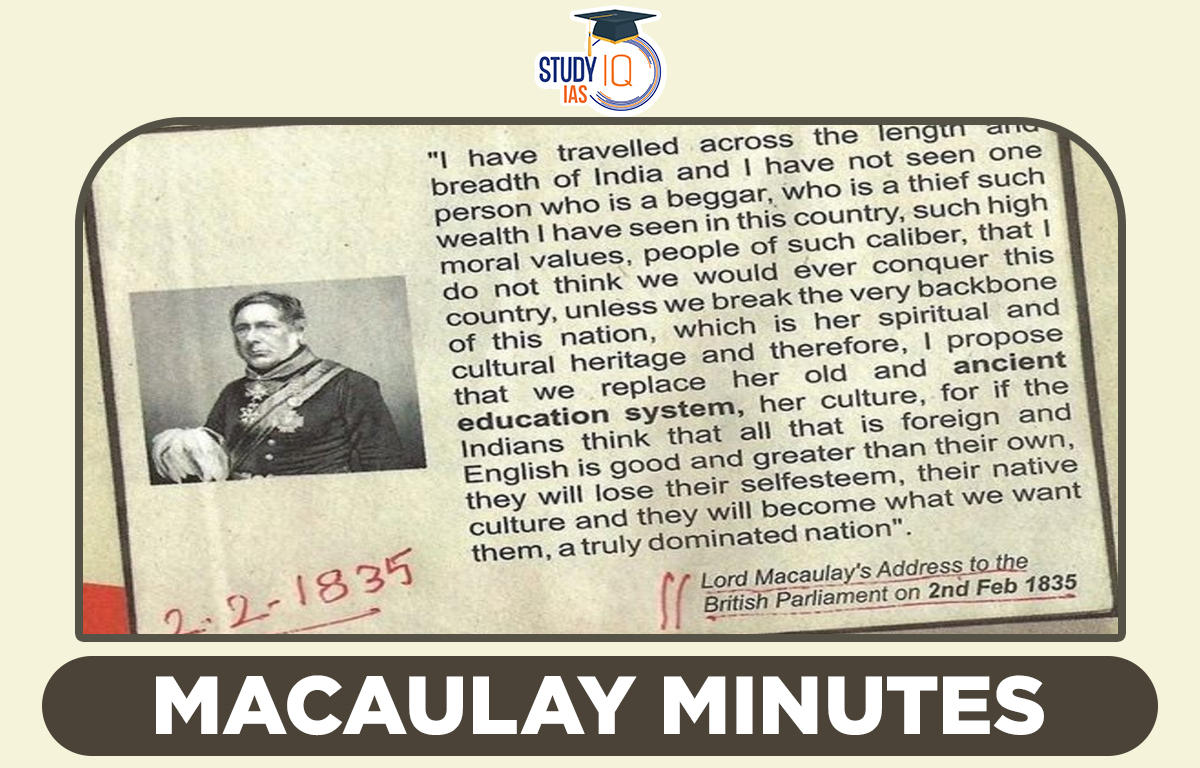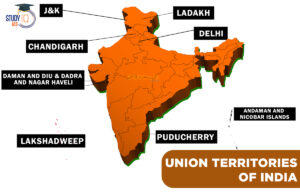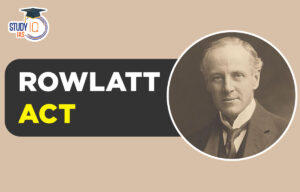Table of Contents
Macaulay Minutes
Thomas Babington Macaulay, a British politician and historian, gave his “Minute on Indian Education” speech on February 2, 1835, in an effort to prove that Indian “natives” needed to be educated in English. The famous Lord Macaulay’s Minute resolved the conflict in favour of the Anglicists; the constrained government funds were to be used only for the English-language instruction of Western sciences and literature.
In terms of the physical and social sciences at the period, Lord Macaulay was right when he said that “Indian learning was inferior to European learning.” This article will examine Lord Macaulay’s Minute (1835), which is useful for preparing for the UPSC Examination.
Read More: Judicial System in British India
Lord Macaulay History
Thomas Babington Macaulay was a British Whig politician and historian who lived from 25 October 1800 to 28 December 1859. He is credited as being the main architect of India’s shift to a Western-style educational system. Macaulay published a lot of essays on modern and historical sociopolitical topics as well as reviews.
Since its publication, The History of England has been praised for its literary style even after broad criticism of its historical claims became fashionable in the twentieth century. It was a seminal and quintessential example of Whig history. Throughout his entire academic and political career, Macaulay Minute continuously stressed the perceived superiority of Western culture.
” When we move from works of fiction to works in which facts are recorded and general principles are investigated, the superiority of the Europeans becomes absolutely immeasurable, Macaulay wrote in his February 1835 Minute on Indian Education. “A single shelf of a good European library was worth the entire native literature of India and Arabia.”
Macaulay was deeply committed to the idea of progress, especially as it related to liberal liberty. Although he idealized ancient European culture and customs, he was a vocal opponent of radicalism.
Read More: Education System in British India
Macaulay Minutes on Education
The primary objective of British education policy in colonial India was to produce money through trade and other methods at first, and it was almost nonexistent. As the importance of education came to be understood throughout time, the firm started to build a few institutions of higher education. Sanskrit, Arabic, and Persian were only a few of the languages taught at these learning institutions. Persian used as the court tongue as well.
The country’s first significant step toward modern education was the Charter Act of 1813. This law allocated Rs. 1 lakh each year for the purpose of teaching the subjects. ‘ It should be mentioned that there were already missionaries in the nation working in this area. However, their main focus was on offering religious instruction with the intention of converting the “heathen” locals to Christianity.
The country’s first significant step toward modern education was the Charter Act of 1813. This law allocated Rs. 1 lakh each year for the purpose of teaching the subjects. ‘It should be mentioned that there were already missionaries in the nation working in this area. However, their main focus was on offering religious instruction with the intention of converting the “heathen” locals to Christianity.
Read More: Wood’s Despatch
Macaulay Minute Objectives
- Spending Only on Western Education: According to Macaulay, the government should only fund western education and not any other type of education.
- College Closure: He pushed for the closure of all universities that only offered courses in eastern philosophy.
- Downward Filtration Theory: He also argued that just a small number of Indians should receive government education; these Indians would then instruct the rest of the populace. The “downward filtering” policy is what is meant by this.
- Indian by Blood & British by Taste: He wanted to cultivate a group of Indians who could support and uphold British interests. This group would be “Indian by blood and colour, but English by likes, beliefs, morality, and intellect.”
Read More: Hartog Committee
Macaulay Minute Features
On June 10, 1834, Lord Macaulay arrived in India as a lawyer serving on the Governor General’s Executive Council and was chosen to lead the Committee of Public Instruction. He was charged with resolving a conflict between Orientalists and Anglicists in 1835. In February 1835, he provided the council with his renowned minutes, which Lord Bentik accepted. A resolution was adopted in March 1835.
The British government should focus primarily on promoting European science and literature among Indians, and “all money appropriated for the purpose of education would be best spent on English education alone,” according to the British government. No stipend shall be awarded to any students who may afterwards enroll in any of the schools under the committee’s supervision. All currently employed academics and students at all institutions shall continue to receive stipends.
The publication of oriental works was not to be financed by public monies. Future government spending would be entirely devoted to educating Indians in English literature and science.
Read More: Civil Service under British Administration
Macaulay Minute Advantage
The first benefit of Macaulay’s Minutes for Indians was that it helped the English language spread throughout India. There is no denying that later on, English had a big impact on India’s freedom efforts.
The second benefit that Macaulay’s Minutes gave to Indians was that it contributed to laying the foundation for contemporary education in that nation. It marked a change from the indigenous traditional educational system to a formalized modern educational system.
Another advantage of Macaulay’s Minutes was that it provided access to world literature. As a result, new literary genres and writing techniques emerged. Additionally, it served as a template for Indians to investigate the present educational system in their nation and compose reports to raise the bar of education there.
Read More: Morley-Minto Reforms
Macaulay Minute Disadvantage
Macaulay’s Minutes was stoking the fires of “The Oriental-Occidental Controversy,” not putting an end to it. Any argument put forth by the orientalists was ignored by Macaulay. He not only ignored their pleadings, but also insulted them angrily. It was the beginning of modern education in India, therefore even while his assertion that English was the key to modern knowledge was accurate, it was impractical to educate Indians at all levels in the language at the time.
It is unjustified for Macaulay to assert that the only language of instruction is English. Additionally, some Indian languages have gone unstudied. His remark that “a single shelf of a great European library was worth the whole native literature of India and Arabia” further offended the native population. The illiterate and educated segments of society were created as a result of the contentious “Downward Filtration Theory” that Macaulay’s Minutes advanced. His downward filtration idea was a failure for Indians.
The wealthy class never helped the lower class raise their level of living or receive a better education. It merely served to foster the growth of people like Mohan Lal, who humiliated even their spouses owing to their ignorance. The idea that Macaulay was in charge of bringing about a new educational strategy in India is likewise untrue.
Macaulay Minute UPSC
If not through schooling, then through political parties, the press, pamphlets, public forums, and other channels, modern ideas did reach the masses. However, they did not do so in the way that the rulers had hoped. The only way that modern education helped this process was by providing nationalists with access to fundamental texts in the physical and social sciences, which encouraged them to conduct social analyses. Other than that, the content, organization, and curricula of modern education served colonial interests. To prepare for the UPSC Exam, read this article for all the Macaulay Minute information.


 Indian Sex Ratio 2024 State-wise, NFHS-5...
Indian Sex Ratio 2024 State-wise, NFHS-5...
 Union Territories of India with Capital ...
Union Territories of India with Capital ...
 Rowlatt Act 1919, Meaning, Provisions, R...
Rowlatt Act 1919, Meaning, Provisions, R...

















